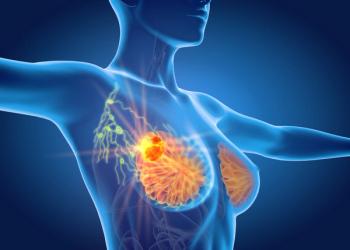
Efficacy Improvement Observed in Nivolumab Combo in Advanced GI Cancers
Results from an observational study found nivolumab plus chemotherapy helped enhance overall survival and progression-free survival for patients with advanced or metastatic gastric cancer, gastroesophageal junction cancer, or esophageal adenocarcinoma.
Overall survival (OS) and progression-free survival (PFS) rates were improved when first-line nivolumab (Opdivo) plus chemotherapy was given to patients with advanced or metastatic gastric cancer, gastroesophageal junction cancer, or esophageal adenocarcinoma, according to a study presented at the
The median OS was 12.6 months in the combination arm vs 10.0 months in the chemotherapy alone arm (HR, 0.76; 95% CI, 0.58-1.00; P = .0468). At 3 months the OS rate was 83.2% vs 84.2%, at 6 months it was 75.8% vs 70.4%, at 9 months it was 61.3% vs 56.1%, and at 12 months it was 53.3% vs 38.1% between the combination and monotherapy arms, respectively.
The median progression-free survival was 7.0 months (95% CI, 6.0-7.8) in the nivolumab arm vs 5.7 months (95% CI, 5.1-6.4) in the chemotherapy alone arm. At 6 months, the PFS rate was 60.0% vs 48.2%, and at 12 months it was 20.1% vs 19.2% between the combination and monotherapy arms, respectively.
“This is one of the first real-world studies of nivolumab plus chemotherapy for the first-line treatment of advanced gastroesophageal adenocarcinoma since its approval by the FDA in April 2021,” Ian Chau, MD, FRCP, professor, and consultant medical oncologist from The Royal Marsden NHS Foundation Trust, said during the presentation.2
This retrospective and observational study enrolled 528 patients with 231 receiving nivolumab plus chemotherapy and 297 receiving chemotherapy alone.1 Patients were selected based on electronic health records data from the Flatiron database who were older than 18, fit the study parameters for the patient population, and received the combination or monotherapy alone between April 1, 2021, and December 31, 2022.
Patients were excluded if they had received trastuzumab before the start of the study treatment or an experimental drug during the study period.
Of the patients enrolled, 53.7% in the combination arm and 36.7% in the chemotherapy arm had a combined positive score (CPS) test. In patients tested for PD-L1 CPS of 5 or more occurred in 54.8% of patients.
The median age at treatment initiation was 66.0 years old vs 67.0 years, 72.7% vs 66.7% of patients were male, and 58.9% vs 59.6% of patients were White in the nivolumab and monotherapy arms, respectively. Additionally, the most common disease between arms was gastric cancer (42.9% vs 47.1%), and most patients were diagnosed with metastatic disease (79.2% vs 69.7%) and had an ECOG performance status of 1 (34.2% vs 34.7%).
During treatment, 37.7% of patients in the nivolumab arm and 46.5% in the monotherapy arm died.
The median OS for patients with a CPS of 1 or more was 15.4 months in the nivolumab arm vs 8.9 months in the chemotherapy alone arm (HR, 0.67; 95% CI, 0.40-1.11; P = .1179). For those with a CPS of 5 or more, the median OS was 14.6 months in the combination arm and 8.9 months in the chemotherapy alone arm (HR, 0.58; 95% CI, 0.31-1.10; P = .0928).
Between the combination and monotherapy arms, the median PFS for patients with a CPS of less than 1 was 8.1 months (95% CI, 2.1-not reached), vs 5.6 months (95% CI, 4.6-7.0); a CPS of 1 or more was 7.5 months (95% CI, 5.6-8.5) vs 6.3 months (95% CI, 4.7-9.5); a CPS of less than 5 was 8.1 months (95% CI, 5.6-15.4) vs 6.1 months (95% CI, 4.8-7.9); and a CPS of 5 or more was 6.9 months (95% CI, 4.7-8.5) vs 5.5 months (95% CI, 2.6-9.5).
Limitations to the study were also presented and included the data gathered from the Flatiron Health database as there is no complete inpatient data or medical histories outside of the oncology platform. Additionally, there is variability in monitoring and collecting data in a real-world trial vs a randomized and controlled one. The data were also collected from community practices and may not apply to academic or other settings.
References
- Chau I, Barzi A, You M, et al. Real-world (RW) effectiveness of nivolumab plus chemotherapy (NIVO+chemo) in patients (pts) with advanced or metastatic gastric carcinoma, gastroesophageal junction carcinoma, or esophageal adenocarcinoma (GC/GEJC/EAC). Presented at the 2024 Gastrointestinal Cancers Symposium; San Francisco, CA, January 18-20, 2024. Poster 295.
- FDA approves nivolumab in combination with chemotherapy for metastatic gastric cancer and esophageal adenocarcinoma. News release. FDA. April 16, 2021. Accessed January 18, 2024. https://shorturl.at/hlxT4
Newsletter
Stay up to date on recent advances in the multidisciplinary approach to cancer.
















































































